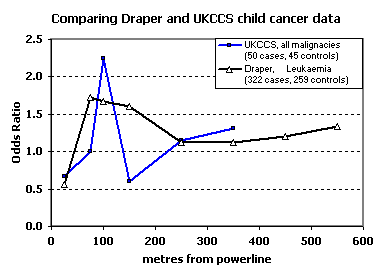 |
 |
|
 |
 |
About Us | Contact |
|
|
22/06/2005 - Childhood Cancer and Power linesThis is a response to the paper, and rapid-response letters, recently published in the British Medical Journal, "Childhood cancer in relation to distance from high voltage power lines in England and Wales: a case-control study", by Gerald Draper, Tim Vincent, Mary E Kroll and John Swanson [1]. Their paper showed an approximate doubling in childhood leukaemia between 50 to 100 metres from National Grid's 275 kV and 400 kV high-voltage electricity transmission line network, with a rise again from about 250 metres to well over 600 metres. There was also a slight rise in brain tumours after 250 metres. Despite the statements of some scientists closely connected with the Leukaemia Research Fund (LRF) who seem determined to dismiss the EMF link with childhood leukaemia, the UK Childhood Cancer Study (UKCCS) [2] did find elevated incidence of childhood leukaemia close to powerlines. When the UKCCS data is plotted as simple Odds Ratios for 275 kV and 400 kV powerlines [3], it shows a similar peak as this latest study at 100 metres and, more importantly, rising again after 150 metres. 
This new study supports a likely magnetic field effect on child leukaemia incidence near to powerlines. 100 metres is beyond the typical 400 nanotesla point, but this is without taking polarisation / ellipticity of the field into account which induces higher currents in people and will be likely to increase the effective distance [4]. After a dip, both studes then show an ongoing rise in incidence after a few hundred metres which would closely fit the Henshaw charged aerosol hypothesis. Actual measurements [5] have found charged aerosol effects at ground level from about 150 metres to several km from powerlines - a long way from the source of the corona ions and affecting a significant number of people. If Denis Henshaw and his team are right, then the adverse health effects of powerlines will extend to well over 1 km from the powerlines. It would be easy to test for this by extending the analysis of the Draper data up to a distance of at least 2km to see how far the elevated risk continues. - Alasdair Philips Refs: [2] UKCCS Investigators, Childhood cancer and residential proximity to power lines, 2000, Br.J.Cancer, 83(11), 1573-1580 [3] Graph available at: [4] Ainsbury, E, et al, Conference poster, [5] Fews A.P., et al, Modification of atmospheric DC fields by space charge from high voltage power lines, 2002, Atmospheric Research, 63: 271 - 289 |

